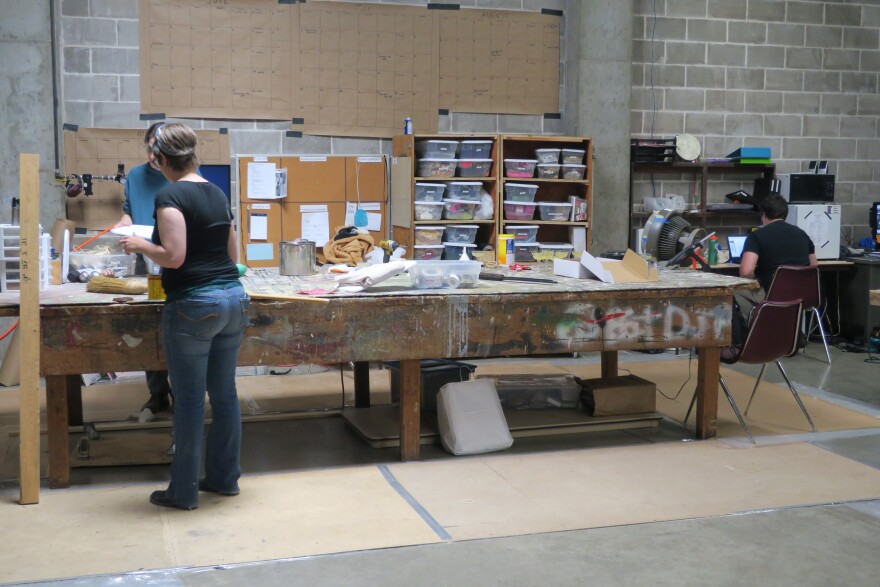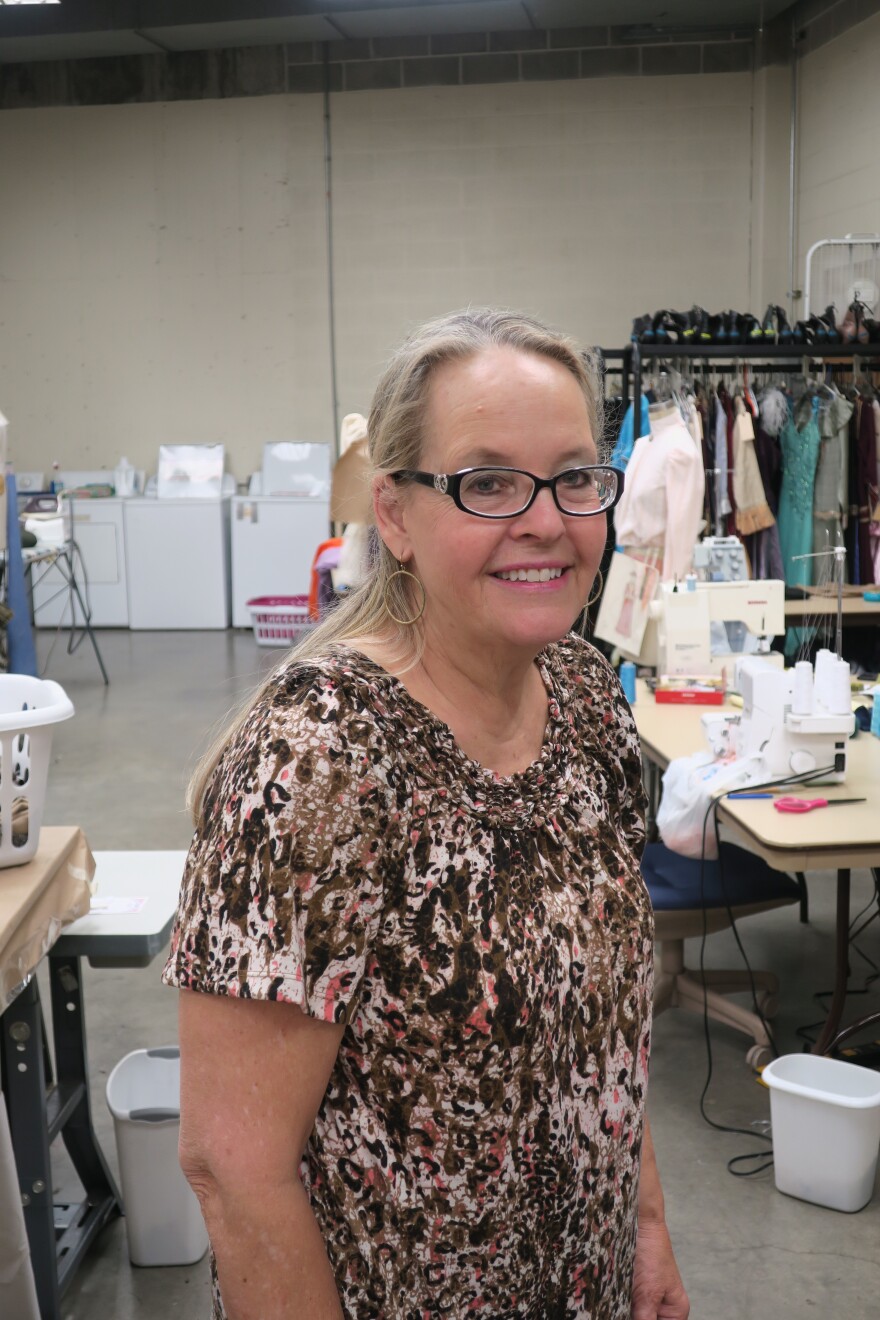Music Theatre Wichita will wrap up its summer season with Disney’s "Newsies," which began Aug. 11.
The professional theatre company is one of the first regional theatres in the nation to create its own brand-new version of the mega-hit show, which ran on Broadway from 2012 to 2014.
Before the cast takes the stage at Century II for the performances, a crew of hundreds works to get costumes, props and scenery ready to go.
Producing artistic director Wayne Bryan is showing off a huge mobilized paint frame, something he calls a hidden gem for Music Theatre Wichita.

Sheets of muslin are stitched together to cover a 26 by 55-foot metal grid. There’s an electronic pulley system at each end. The paint frame moves up and down so an artist can access any portion of it while standing on the main floor.
"It can be stopped at any moment so that a painter can always paint at eye level," Bryan says. "This is like an artist’s canvas and we attract real artists because this is how artists work."

Ashley Bailey and several other artists paint highly detailed scenic backdrops that add depth and set the story in each show.
Some of the imagery that they've created recently includes the colorful mountains for "The Wizard of Oz" and the New York City streetscapes for "West Side Story" and "Newsies."
"The best thing about painting a drop up versus on the ground, as most theatres do, is the fact that we can step back and see what it’s going to look like on stage," Bailey says. "Whereas if it’s on the floor, you only have so much concept of the perspective you’re looking at."
Bailey started as a painter 10 years ago. Now, she’s running the shop and supervises a team of eight artists. She knows that her team is getting experiences that will help them land jobs on Broadway or at other regional theatres.
"We are one of the few companies left that really does backdrops anymore," Bailey says. "There are so many people who rent them now, and it gives new artists an opportunity to learn a skill that they are not being taught in school anymore."
Music Theatre Wichita has been based at Century II for more than 45 years. Having the paint shop and three other workshops in-house allows the theatre company to create five original Broadway-scale productions each season.
Related: Wichita Performing Arts Groups Watching Closely As City Considers Future Of Century II
Bryan says other professional companies don’t have an opportunity of using a paint frame.
"This is pretty rare," Bryan says. "It’s hard to imagine too many buildings being newly built and deciding to add one of these paint frames because it takes up a good amount of space and it’s not used by every tenant that could come into a facility."
The paint shop is at stage level. The workshops--where other scenery, costumes and props, are created--are in the basement.

In the prop shop, crew members are building the things that actors carry or use in a scene, along with the furniture decorations and even wastebaskets – anything that helps bring a script to life on stage.

"Sometimes people joke that props are no bigger than a breadbox, but we have [created things] quite a bit bigger than that," says prop master Anna Rosell.
Rosell and her team draw on the supplies they have on hand for their creations, or they order specialty items online. Shelves lining the wall are filled with dozens of bins of fabric, wood scraps and string.
"We build all of the furniture, all of the dressing, any curtains and brooms," Rosell says. "The great thing about props is that you can be doing anything any day, from building carpentry to sewing. You never know what you are going to get when you walk in here each day."
On the other side of the prop shop is the costume shop.

The team here builds dozens, sometimes hundreds, of costumes each season. Seamstress and shop manager Deborah Roberts carefully inspects the costumes for durability.

"This is the only place that I know of that you can actually come and create costumes from scratch, working with the designer, working with cutter/drapers, working with first hands, working with stitchers," Roberts says. "Most shows come in on a truck that’s already built, so you don’t get the experience that you do here."
Music Theatre Wichita often rents out its costumes, hand-painted backdrops and scenery to other theatre companies and schools.
Producing artistic director Wayne Bryan says their thriving rental business makes up about 10 percent of Music Theatre’s $4.1 million annual budget.
"One of the reasons our rental business is so strong out of Wichita is there are very few theatres who can do this now," Bryan says. "We own 60 shows, either sets or costumes or both, and that is one of our self-sustaining elements."

This behind-the-scenes theatre work attracts people from all over the country. More than 250 people learn technical theatre skills and build their portfolios at Music Theatre Wichita.

Scene shop foreman Cameron Lazear says the best part of his job is the fun people in his shop. He also takes pride in knowing that the sets he builds will live on after a show closes locally.
"It’s very nice to see big main stage places all across the U.S. have rented our stuff," Lazear says. "We have 'Beauty and the Beast' up in Alaska, so that’ s pretty awesome to know that a show I did some work on is all the way there."
The production crew only gets a few weeks to build the sets, props and costumes before a show opens. Bryan says that’s part of the magic of Music Theatre Wichita: Most people don’t realize the demanding planning, designing, rehearsals and technical work that’s necessary to get a production onstage.
"People come and sit down and see a show, and we’re polished, and we look like anything that you might see on Broadway or on a national tour," Bryan says. "So I don’t think people sit down and actually think about that goes into it."
When they pack up the backdrops, wash the costumes one last time and strike the workshops, Music Theatre Wichita will go dark until next summer.
The theatre company could be facing a new chapter in its history: The City of Wichita is now working on its long-term plan for the future of Century II.
The city has not yet decided if it plans to remodel or replace the nearly 50-year-old building. A consultant is studying the possibility of a public-private partnership and other revenue sources such as naming rights as financing options. A report is due soon.
City leaders hope to present a proposal to city council by the end of the year.
--
Follow Deborah Shaar on Twitter @deborahshaar
To contact KMUW News or to send in a news tip, reach us at news@kmuw.org.






